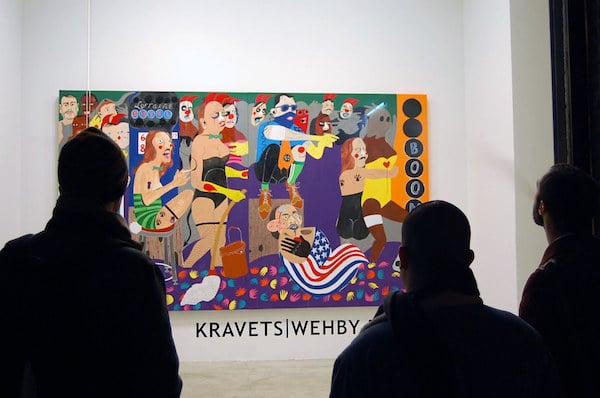As working artists grow their careers, they often struggle to get information on specific business quandaries. At CHF, we gather the most common questions, and canvass those professional artists who are part of our expert network to see how they’ve dealt with a particular situation. Today, we cover the issue of how to get a gallery to represent you. As you can see from the responses below, there is no one right answer, and different artists take slightly different approaches to achieving the same end. Ultimately, you must find what works best for you.

Jane Robinson: The best way to get gallery representation is to start in your own geographic area. Go to local galleries, and take a look around. Never bring in your portfolio and ask the curator or owner to take a look. Initially, you are trying to see if the gallery is a good fit for your work and build a relationship. You might ask about their submission policy and any upcoming group shows. Attend a few of their events and network with their artists and staff. Often, another artist refers you and your work to the gallery owner. Build relationships first; promote yourself later.
Now, thanks to the Internet, you can do a lot of your homework from the comfort of your own home. Scope out galleries where your work might be good fit–in terms of style, price, etc. Most galleries post submission guidelines, so be sure to follow them and demonstrate that you are a professional. There is a growing segment of online galleries, too. People are getting very accustomed to buying artwork online, and neither you nor they are restricted by geography. (Jane Robinson Abstract Art)
Bette Ridgeway: Before approaching a gallery you will need: a body of cohesive work (20-30 pieces), a stunning website, great photos, a pricelist, a bio, and an artist statement.
Research the galleries that you wish to approach. Does your work fit? If you know an artist who is already showing in said gallery, ask that artist to write the owner/director on your behalf to recommend your work, with a link to your website.
Another option is to visit the gallery with your smartphone or tablet. Introduce yourself and your work, and scroll through your images. The owner will know in six seconds whether he/she connects with your work. That saves time, and impresses the gallery with your digital presence.
In the meantime, build your online presence and branding, and network. Galleries love to take on artists who already have a following and can assist in the marketing and promotion of the gallery. (Ridgeway Studio)
Krystii Melaine: First, make sure both you and your art are ready for gallery representation. Your art needs to be of consistently good quality, made of quality materials that will last, be well-presented and professionally finished, and be something that clients of the gallery are likely to want to buy. You need to be ready to enter a business partnership with a gallery, and be professional, easy to work with, reliable, responsive, and behave with integrity.
Then, do your research. Find a gallery where your work fits with the taste, style, price range, and level of artists represented. Follow any guidelines they have on their website about artist submissions. Most galleries don’t have time to speak to every artist who wanders in with a portfolio.
If you are able to visit the gallery in person, introduce yourself and have your portfolio ready in case they are interested, but don’t take up their time if they are busy. Let them know you would like to submit your work for consideration, then make sure you do it within a day, and follow up in a week or two if you don’t hear back from them.
If you get a rejection, find another gallery and try again. If you get negative feedback on your work, be honest and assess whether or not you need to improve or modify it to be more suited to galleries. If your work is good, and you have chosen your target galleries wisely, you will be successful. (Krystii Melaine Fine Art)

Watie White: The process is social: you attend the openings, and befriend the directors/curators whose taste you appreciate, as their tastes probably involve your work as well. Over time, the partnership evolves organically.
However, when you live in a non-major art market (like Omaha, Nebraska, where I’m based), the galleries that are available don’t add much value to your career in terms of regular highlighted exhibitions, access to an intellectual community, and/or promotion to build your collector base. What do you do then?
In my experience, you start by asking yourself what it is that you are expecting to receive from the gallery relationship. Prestige and affirmation? Or, most likely, to have someone else handle sales and market-building? Once you’re able to answer that question, you may have to address other means of handling those parts of your career. In my experience, that has involved building other partnerships to exhibit new work and have it well-represented; doing the hard work of building my market, collector by collector; and keeping an eye toward sales and other non-sales income to further my creative development. (WatieWhite.com)

Bart Walter: Assemble a body of consistently good work, and then photograph it beautifully. Next, you need to talk with artists you admire about which galleries they respect and why. Choose several galleries that seem as though they may be a good fit.
And now comes the hard part. You need to take those beautifully photographed images of your work (along with a one page bio sheet), put them in an elegant presentation case, and walk into the galleries you have chosen, one by one. Walk around the gallery. Notice how they treat customers, and respectfully study the works already on exhibit. When the gallery owner (or person in charge) is not busy, engage him or her in conversation, and then casually ask if they have a moment. Open your case and show a few images, tell them who recommended their gallery and why. Compliment them on the art already on display.
Do not expect the gallery owner to offer you anything. In fact, you can be reasonably sure the initial response will be no. Listen to the gallery owner. Acknowledge his or her concerns. Be patient and polite. If your work is a good fit for the gallery, the owner may look through your entire portfolio. That is a good sign. Ask how they work with their artists. Tell them why you think your work would be a good fit for their gallery. Patiently listen to their response.
If you receive a firm no, do not take it personally. Try the next gallery on your list. If you get a no, yet perceive that there may still be a way forward, explore that possibility. Over the years, I have been turned down by so many galleries and museums that I lost count long ago. However, some of those initial rejections have turned into career-changing partnerships and wonderful professional relationships. Acquisition of my first gallery representation started just that way. (BartWalter.com)
This month, we’d also like to share an excerpt of a response we received when we crowdsourced this question:
Shelley Ashfield (Philadelphia, PA): Join a well-respected community arts center in your area. As a member, you will be eligible to enter juried shows. Enter as many of these shows as you can, paying close attention to the requirements in the call-for-entries form.
As your work is shown, the director of the arts center will become more familiar with your work. Arts-center directors are also often the curators of important exhibitions throughout the year, and they keep a Rolodex of artists who fit their vision in their heads. It’s also a good idea for you to print up business cards with a mini reproduction of one of your pieces, for folks to have a quick visual reference of your work.
Enter your work in art shows benefiting local organizations. A commission for every work sold goes to the organization. To keep the quality high, these shows are often juried, and to be invited back the next year, your work must sell. As you gain more followers, keep making sure they say good things about your work on Facebook and Twitter.
After some years of gaining a great reputation, find an area gallery that exhibits work of the type that you specialize in, and prepare to hand the director/curator your c.v. and business card.
Some opportunities will work well for you; others will not. It will take more than a few of these opportunities to get a feel for it.
If you found this post valuable, here are three ways to support CHF:
- Email us your burning questions about the business of art.
- Share this article on social media by clicking on the links under the title above.
- Make a tax-deductible donation so that we can continue this important work.







